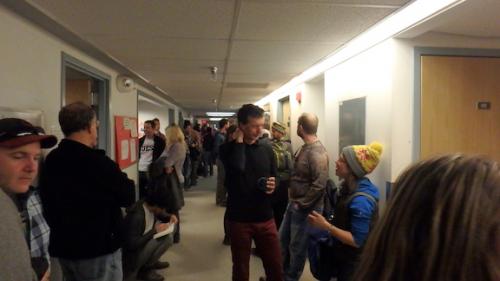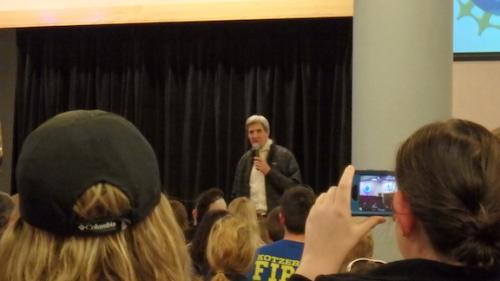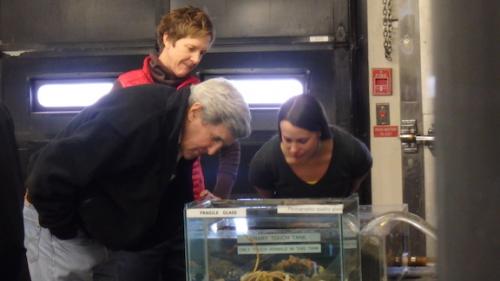This week, McMurdo Station hosted Secretary of State John Kerry, the highest ranking US official ever to visit the continent. The Secretary's visit was a weather-delayed forty-eight hour whirlwind tour of the Dry Valleys, the Cape Royds Adelie penguin colony, Ernest Shackleton's 1907 supply hut, and McMurdo Station itself. Standing in front of an audience of about 300 USAP participants, on Friday evening in the galley, Secretary Kerry gave a talk that was both funny and sobering on the history of the modern environmental movement and the unfolding climate crisis. According to news reports and his own spokesperson, Secretary Kerry is visiting Antarctica to highlight concerns over climate change, to gain first hand experience with the Antarctic environment, and to talk with climate researchers prior to a climate conference in Marrakesh, Morocco. In my opinion, the Secretary's visit carries much greater significance.
 USAP participants line up in the hallway outside of the galley before being admitted to listen to Secretary Kerry speak.
USAP participants line up in the hallway outside of the galley before being admitted to listen to Secretary Kerry speak.
The Secretary of State of the United States is the federal government's top diplomat and is responsible for communicating the US government's messages and policies to foreign governments, among other duties. The Secretary heads the Department of State, which operates and staffs embassies and consulates in around 180 nations. These diplomatic "missions" are themselves tiny plots of physical US territory located within other countries (reciprocal arrangements exist with other countries wherein their embassies within the US are considered foreign territory). A large part of what makes a country a country is the legitimacy lent to it by other foreign powers. This recognition often comes through the establishment of diplomatic relations in the form of official visits by high-ranking diplomats, the opening of an embassy, and the appointment of an ambassador.
 Secretary of State John Kerry addresses an audience of around 300 people in the McMurdo Station dining hall.
Secretary of State John Kerry addresses an audience of around 300 people in the McMurdo Station dining hall.
With no permanent population to speak of, Secretary Kerry's physical presence in Antarctica serves the symbolic purpose of re-affirming the United States' ongoing support for the Antarctic Treaty System. The cold war-era agreement - forged by diplomats of 12 nations and ratified by the US Senate and President Eisenhower - once played a role in averting nuclear war. Since 1959, the original treaty has been amended several times and now contains provisions for the preservation of the continent's natural resources in addition to the original prohibitions on armed military activity, nuclear testing, and nuclear waste disposal. Some of these provisions will expire in the next 25 years, potentially leading to conflicts among the signatory nations of the Antarctic Treaty System. Secretary of State John Kerry's presence at McMurdo Station tells the world that the United States hasn't forgotten about Antarctica and its historical and future geopolitical significance.
 Secretary Kerry, Dr. Amy Moran, and Science Implementer Beverly Walker inspect a touch tank housing some of the McMurdo Sound organisms protected within the Ross Sea Marine Protected Area.
Secretary Kerry, Dr. Amy Moran, and Science Implementer Beverly Walker inspect a touch tank housing some of the McMurdo Sound organisms protected within the Ross Sea Marine Protected Area.
